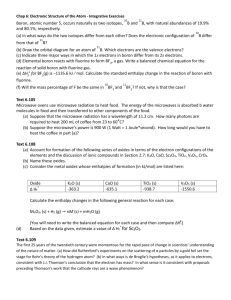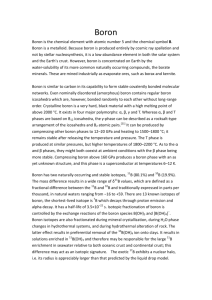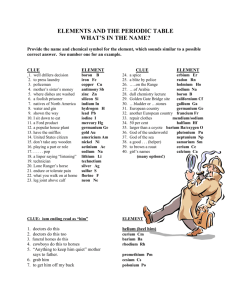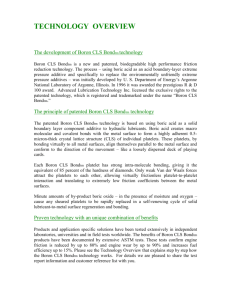g - Agilent Technologies
advertisement
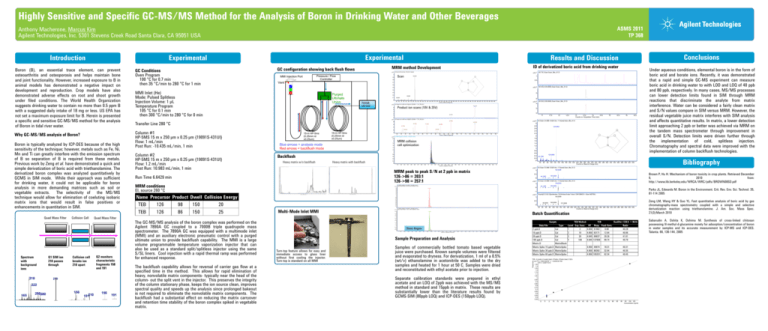
Hi hl Sensitive
Highly
S i i andd Specific
S ifi GC
GC--MS/MS Method
M h d for
f the
h Analysis
A l i off B
Boron iin Drinking
D i ki Water
W
andd Other
O h Beverages
ASMS 2011
TP 368
Anthony Macherone, Marcus Kim
Agilent
g
Technologies,
g , Inc. 5301
5
Stevens
S
Creek
C
Road Santa
S
Clara,
C , CA
C 95051
5 5 USA
S
I t d ti
Introduction
Boron (B),
B
(B) an essential
i l trace element,
l
can prevent
osteoarthritis and osteoporosis and helps maintain bone
and joint functionality.
functionality However,
However increased exposure to B in
animal models has demonstrated a negative
g
impact
p
on
development and reproduction. Crop models have also
demonstrated adverse effects on root and shoot growth
under
d filed
fil d conditions.
diti
Th World
The
W ld Health
H lth Organization
O
i ti
suggests drinking water to contain no more than 0.5
0 5 ppm B
with a suggested
gg
dailyy intake of 18 mgg or less. US EPA has
not set a maximum exposure limit for B. Herein is presented
a specific and sensitive GC-MS/MS method for the analysis
off Boron
B
i tidal
in
tid l river
i water.
t
GC Conditions
Oven Program
100 °C for 0.7 min
then 35 °C/min to 280 °C for 1 min
Why GC-MS/MS analysis of Boron?
Column #1
HP 5MS 15 m x 250 μm x 0.25
HP-5MS
0 25 μm {19091S-431UI}
{19091S 431UI}
Flow: 1 mL/min
Post Run: -10.435 mL/min, 1 min
Spectrum
with
background
ions
210
Q1 SIM ion
210 passes
through
Collision Cell
Collision cell
breaks ion
210 apart
Quad Mass Filter
Q2 monitors
i
characteristic
fragments 158
and 191
210
222
165
268280
158
191210
158
191
MRM method Development
GC configuration
config ration showing
sho ing back flush
fl sh flows
flo s
ID of derivatized boric acid from drinking
g water
x10 7 +EI TIC Scan Scan_Mix_01.D
Scan
Pressure / Flow
Controller
MMI Injection Port
R lt andd Discussion
Results
Di
Ri lt andd Discussion
Results
Di
i
1
0.5
Vent
EI EIC(125.0000) Scan Scan
Scan_Mix_01.D
Mix 01.D
x10 5 +EI
MMI Inlet (He)
Mode: Pulsed Splitless
Injection Volume: 1 μL
Temperature Program
105 °C for 0.1 min
then 300 °C/min to 280 °C for 0 min
Purged
P
d
Ultimate
Union
5
0
7000B
MS/MS
x10 6 +EI EIC(126.0000) Scan Scan_Mix_01.D
4
Product ion scans (10V & 25V)
2
0
11
11.5
12
12.5
13
13.5
14
14.5
Counts vs. Acquisition Time (min)
15
15.5
16
16.5
Transfer Line 280 °C
C
Column #2
HP-5MS 15 m x 250 μm x 0.25 μm {19091S-431UI}
Flow: 1.2 mL/min
Post Run: 10.983
10 983 mL/min,
mL/min 1 min
15-m HP-5ms
(0.25mm id
x0.25um)
Blue arrows = analysis
Bl
l i mode
d
Red arrows = backflush mode
Heavy matrix w/o backflush
The backflush capability allows for reversal of carrier gas flow at a
specified time in the method. This allows for rapid elimination of
h
heavy,
nonvolatile
l til matrix
t i componentst typically
t i ll near the
th head
h d off the
th
column- out the split vent in the injector.
column
injector This preserves the integrity
of the column stationary phase, keeps the ion source clean, improves
spectral quality and speeds up the analysis since prolonged bakeout
is not required to eliminate the nonvolatile matrix components.
components The
backflush had a substantial effect on reducingg the matrix carryover
y
and retention time stability of the boron complex spiked in vegetable
matrix.
ti
C l i
Conclusions
Under
U
d aqueous conditions,
diti
elemental
l
t l boron
b
i in
is
i the
th form
f
off
boric acid and borate ions.
ions Recently,
Recently it was demonstrated
that a rapid and simple GC
GC-MS
MS experiment can measure
boric acid in drinkingg water to with LOD and LOQ of 40 pp
ppb
and 80 ppb, respectively. In many cases, MS/MS processes
can lower detection limits found
f
in SIM
S
through MRM
reactions that discriminate the analyte from matrix
interference Water can be considered a fairly clean matrix
interference.
and S/N values compare
p
in SIM versus MRM. However,, the
residual vegetable juice matrix interferes with SIM analysis
and affects quantitative results. In matrix, a lower detection
li it approaching
limit
hi 2 ppbb or better
b tt was achieved
hi d via
i MRM on
the tandem mass spectrometer through improvement in
overall S/N. Detection limits were driven further through
the implementation of cold, splitless injection.
Chromatography and spectral data were improved with the
i l
implementation
i off column
l
b kfl h technologies.
backflush
h l i
Bibliography
Heavy matrix with backflush
MRM peak to peak S/N at 2 ppb in matrix
126->86 = 203:1
126 >98 = 257:1
126->98
MRM conditions
EI, source 260 °C
The GC-MS/MS analysis
y of the boron complex
p was pperformed on the
Agilent 7890A GC coupled to a 7000B triple quadrupole mass
spectrometer The 7890A GC was equipped with a multimode inlet
spectrometer.
(MMI) and an auxiliary electronic pneumatic control with a purged
ultimate union to provide backflush capability. The MMI is a large
volume
l
programmable
bl temperature vaporization
i i
i j
injector
that
h can
also be used as a standard split/splitless injector using the same
S/SL liners. Cool injection
j
with a rapid thermal ramp was performed
for enhanced response.
MRM collision
cell optimization
Backflush
Run Time 6.6429 min
Name Precursor Product Dwell Collision Energy
gy
TEB
126
98
150
20
TEB
126
86
150
25
15-m HP-5ms
((0.25mm id
x0.25um)
Brown P,
P Hu H.
H Mechanism of boron toxicity in crop plants.
plants Retrieved December
9,
2010
from:
htt //
http://www.lib.berkeley.edu/WRCA/WRC/pdfs/BROWN08SD.pdf
lib b k l
d /WRCA/WRC/ df /BROWN08SD df
Parks JL, Edwards M. Boron in the Environment. Crit. Rev. Env. Sci. Technol. 35,
81 114 2005
81-114
Multi-Mode Inlet MMI
Sample
Noise Region
S
Sample
l Preparation
P
i andd Analysis
A l i
Turn-top feature allows for easy and
immediate access to gglass liner
without first cooling the injector.
Turn-top
Turn
top is standard on all MMI
Zeng LM, Wang HY & Guo YL. Fast quantitative analysis of boric acid by gas
chromatography-mass
chromatography
mass spectrometry coupled with a simple and selective
derivatization reaction using triethanolamine. J. Am. Soc. Mass Spec.
21(3) M h 2010
21(3):March
B h Quantification
Batch
Q
ifi i
Samples
p
of commerciallyy bottled tomato based vegetable
g
juice were purchased. Known sample volumes were filtered
and evaporated to dryness.
dryness For derivatization,
derivatization 1 ml of a 0.5%
0 5%
(wt/v) ethanolamine in acetonitrile was added to the dry
samples and heated for 1 hour at 50 C. Samples were dried
andd reconstituted
i
d with
i h ethyl
h l acetate prior
i to injection.
i j i
Separate
p
calibration standards were pprepared
p
in ethyl
y
acetate and an LOQ of 2ppb was achieved with the MS/MS
method in standard and 15ppb in matrix.
matrix These results are
substantially lower than the literature results found by
GCMS-SIM (80ppb LOQ) and ICP-OES (150ppb LOQ).
Data File
2 ppb.D
10 ppb.D
20 ppb.D
100 ppb.D
Matrix D
Matrix.D
Matrix Spike 15 ppb.D
Matrix Spike 30 ppb.D
Matrix Spike 60 ppb.D
Response
es
Boron is
B
i typically
t i ll analyzed
l d by
b ICP-OES
ICP OES because
b
off the
th high
hi h
sensitivity of the technique; however,
however metals such as Fe,
Fe Ni,
Ni
Mn and Ti can ggreatlyy interfere with the emission spectrum
p
of B so separation of B is required from these metals.
P i
Previous
workk by
b Zeng
Z
et al.l have
h
d
demonstrated
d a quick
i k andd
simple derivatization of boric acid with triethanolamine.
triethanolamine The
derivatized boron complex was analyzed quantitatively by
GCMS in SIM mode. While their approach was sufficient
for drinking water, it could not be applicable for boron
analysis in more demanding matrices such as soil or
vegetable extracts.
extracts
The selectivity of the MS/MS
technique
q would allow for elimination of coelutingg isobaric
matrix ions that would result in false positives or
enhancements
h
t in
i quantitation
tit ti in
i SIM.
SIM
Quad Mass Filter
E anddimental
Results
R
lExperim
Di t l i
Discussion
E
Experimental
i
t l
Type
Cal
Cal
Cal
Cal
MatrixBlank
MatrixSpike
MatrixSpike
MatrixSpike
TEB Method
Level Exp. Conc.
1
2
2
10
3
20
4
100
TEB
RT
4.850
4.850
4.845
4.845
Resp.
51902
63171
69637
137056
4.850 49074
4.850 80392
4.850 105331
Qualifier (126.0 -> 86.0)
Final Conc.
Ratio
0.00
40.28
12.64
40.06
20.26
41.01
99.74
40.79
18.31
32.94
62.34
40.31
40.35
40.45
Sabarudin A. Oshita K, Oshima M. Synthesis of cross-linked chitosan
possessing N-methyl-d-glucamine moiety for adsorption/concentration of boron
in water samples and its accurate measurement by ICP-MS and ICP-OES.
Tl
Talanta.
66 136-144,
66,
136 144 2005

